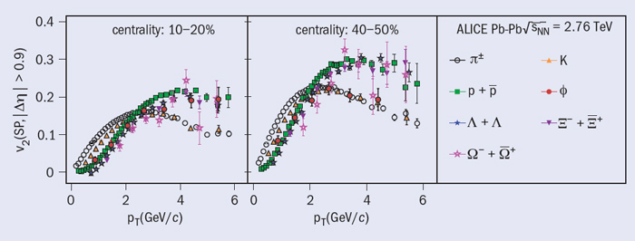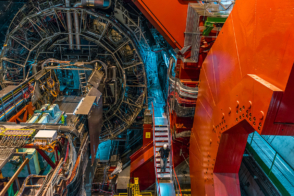Relativistic heavy-ion collisions produce large numbers of particles that do not move individually, but rather as an organized group, with a collective motion known as flow. Flow studies at Brookhaven’s Relativistic Heavy-Ion Collider (RHIC) contributed to the surprising realization that the hot and dense matter created in the collisions behaves like a perfect liquid and not as a hadron gas. Now, the ALICE collaboration at the LHC has looked further into how these effects vary for different particle species.

In relativistic heavy-ion collisions the collective motion, or flow, is governed by the spatial anisotropy of the almond-shaped overlap region of the colliding nuclei and the initial density inhomogeneities of the fireball. These features are transformed, through interactions between the produced particles, into an anisotropy in momentum space. The degree of this transformation depends on the ratio of shear viscosity to entropy, η/s, which quantifies the friction of the created matter. This resulting anisotropy in particle production can be quantified by a Fourier analysis of the azimuthal distribution relative to the system’s symmetry plane, characterized by Fourier coefficients, vn. The second harmonic, v2, is known as the elliptic-flow coefficient.
One of the major outcomes from RHIC was the measurement of the elliptic flow of identified particles. These results led to the conclusion that the matter created acts as a system where the value of η/s is very close to the lower bound of ħ/4πkB conjectured within anti-de Sitter/conformal field theory – i.e. a nearly perfect liquid. At low values of transverse momentum (pT), for pT < 2 GeV/c, the experiments found an interesting mass-ordering of v2(pT), attributed to the interplay between elliptic and radial flow.
Radial flow tends to create a depletion in the particle pT spectrum at low values, which increases with increasing particle mass and transverse velocity. When introduced in a system that exhibits azimuthal anisotropy, this depletion becomes larger along the shorter axis of the anisotropy, thereby reducing v2. The net result is that at a fixed value of pT, heavier particles have a smaller value of v2 than lighter ones. In the intermediate pT region (2 < pT < 5 GeV/c), the v2 of baryons is larger than that of mesons. This phenomenon was conjectured to originate within a picture where flow develops at the partonic level and quarks coalesce into hadrons during hadronization. The proposed mechanism was argued to lead to the observed hierarchy in the flow values – the so-called number of constituent quarks (NCQ) scaling.
The ALICE collaboration, profiting from the unique particle-identification capabilities that the detector set-up provides, had measured v2 in PbPb collisions at √sNN = 2.76 TeV for different centrality intervals and various particles: π, K, p, Λ, Ξ–, Ω– (and their antiparticles), K0s and φ. The figure illustrates how v2 develops for different particle species within the same centrality interval in central (left plot) and peripheral (middle plot) PbPb collisions.
A clear mass ordering is seen for all centralities in the low-pT region (i.e. pT ≤ 2 GeV/c). Comparisons with hydrodynamic calculations in this transverse-momentum range indicate that the produced matter at the LHC seems to favour a value of η/s smaller than twice the quantum mechanical limit. In the intermediate pT region (pT > 2 GeV/c), although the particles tend to group according to their type (i.e. mesons and baryons), the NCQ scaling, if any, is only approximate. In particular, the φ-meson, with a mass close to that of p and Λ, seems to follow the baryon band in central events and shifts progressively to the band of mesons for peripheral collisions. This seems to indicate that the mass, rather than the number of constituent quarks, is the driving force of the v2 evolution with pT also in the intermediate region.





